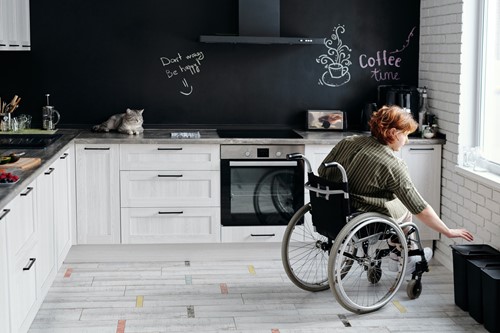
Photo by Marcus Aurelius from Pexels
Contractors and land developers may want to consider the growing demographics of people with some form of physical limitation when they design kitchens. According to recent reports, upwards of 15% of households have at least one family member with a physical limitation. Yet only 6% of available homes are considered accessible.
Over 16% of Americans are over 65 years old, and that figure is expected to increase to 22% by 2050. The normal result of aging eventually causes loss of muscular strength, mobility and the use of wheelchairs and walkers by our valued elders. The market for accessible homes will only continue to grow in the coming years. But integrating accessible kitchen elements in new construction blueprints, real estate values are likely to increase. These are cost-effective designs that increase kitchen accessibility while making the space aesthetically pleasing and efficient.
The Americans with Disabilities Act (ADA) sets guidelines that support improved use by people with mobility, flexibility and other limitations. The underlying reasoning behind many of the standards is to position kitchen items within arm’s reach and remove common impediments. These are aspects of an accessible kitchen that would be consistent with ADA regulations:
The ADA requirements have subtle details that include height, width and pathway layouts. But what homeowners with and without physical limitations like about accessible kitchens are their efficiency and enhanced spaciousness. Many discover that ADA-compliant kitchens look bigger than their actual square footage.
Regardless of whether your involvement in a new construction project comes from the point of view of an architect, contractor or potential homeowner, there’s a simple way to understand accessibility. Start by thinking through those seemingly minor inconveniences in traditional kitchens and resolve them. These are ways kitchens can enjoy improved accessibility.
It’s also important to consider that a fully accessible kitchen leverages a floor plan that allows a person using a wheelchair or walker ease of movement and the ability to turnaround and exit freely. In terms of new home construction, home chefs with or without physical limitations often find the ergonomic benefits and spaciousness appealing.

Connie has been in the Tampa Bay area for over a decade. She has worked with customers and clients from many different backgrounds. Connie has great communication skills, her attention to detail and prompt follow up are attributes her customers appreciate. She is very dedicated to listening to her customers needs. She loves the opportunity to assist her clients with professionalism and courtesy. If you are selling your home or looking for the perfect home to buy, Connie would love the opportunity to serve you.